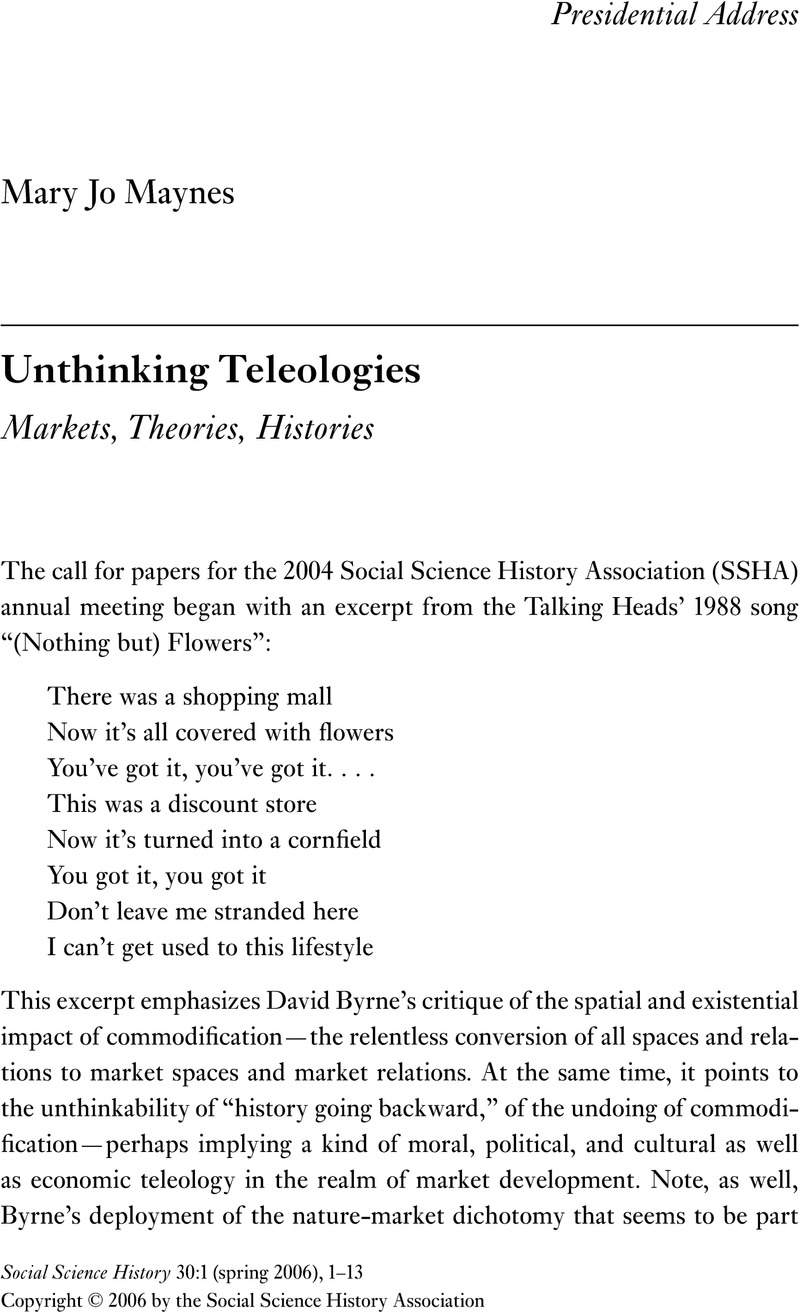No CrossRef data available.
Article contents
Unthinking Teleologies
Markets, Theories, Histories
Published online by Cambridge University Press: 04 January 2016
Abstract
An abstract is not available for this content so a preview has been provided. Please use the Get access link above for information on how to access this content.

- Type
- Presidential Address
- Information
- Copyright
- Copyright © Social Science History Association 2006
References
Becker, Gary S. (1965) “A theory of the allocation of time.” Economic Journal
75: 493–508.Google Scholar
Berg, Maxine (1998) “What difference did women’s work make?” in Sharpe, Pamela (ed.) Women’s Work: The English Experience, 1650–1914.
London: Arnold: 149–72.Google Scholar
Byrne, David (2003) “Learning to love PowerPoint,” September, www.mcsweeneys.net/authorpages/byrne/byrne10.html.Google Scholar
Crowston, Clare (2001) Fabricating Women: The Seamstresses of Old Regime France, 1675–1791.
Durham, NC: Duke University Press.Google Scholar
de la Farelle, François-Félix (1852–54) Etudes économiques sur l’industrie de la soie dans le Midi de la France.
2nd ed. Paris: Guillaumin.Google Scholar
de Vries, Jan (1998) “Between purchasing power and the world of goods: Understanding the household economy in early modern Europe,” in Sharpe, Pamela (ed.) Women’s Work: The English Experience, 1650–1914.
London: Arnold: 215–29.Google Scholar
Dublin, Thomas (1994) Women at Work: The Transformation of Work and Community in Lowell, Massachusetts, 1826–1860.
2nd ed. New York: Columbia University Press.Google Scholar
Gray, Jane (1996) “Gender and uneven working-class formation in the Irish linen industry,” in Frader, Laura and Rose, Sonya (eds.) Gender and Class in Modern Europe.
Ithaca, NY: Cornell University Press: 37–56.Google Scholar
Gray, Marion W. (2000) Productive Men, Reproductive Women: The Agrarian Household and the Emergence of Separate Spheres during the German Enlightenment.
New York: Berghahn.Google Scholar
Gullickson, Gay L. (1986) Spinners and Weavers of Auffay: Rural Industry and the Sexual Division of Labor in a French Village, 1750–1850.
Cambridge: Cambridge University Press.Google Scholar
Lemire, Beverly (1991) Fashion’s Favourites: The Cotton Trade and the Consumer in Britain, 1660–1800.
Oxford: Oxford University Press.Google Scholar
Liu, Tessie P. (1994) The Weaver’s Knot: The Contradictions of Class Struggle and Family Solidarity in Western France, 1750–1914.
Ithaca, NY: Cornell University Press.Google Scholar
Liu, Tessie P. (1996) “What price a weaver’s dignity: Gender inequality and the survival of home-based production in industrial France,” in Frader, Laura and Rose, Sonya (eds.) Gender and Class in Modern Europe.
Ithaca, NY: Cornell University Press: 57–76.Google Scholar
Maynes, Mary Jo (2004a) “Arachne’s daughters: European girls’ labor in the international textile industry, 1750–1880,” in Maynes, Mary Jo, Søland, Birgitte, and Benninghaus, Christina (eds.) Secret Gardens, Satanic Mills: Placing Girls in European History.
Bloomington: Indiana University Press: 38–53.Google Scholar
Maynes, Mary Jo (2004b) “Gender, labor, and the history of globalization: European spinsters in the international textile industry, 1750–1880.” Journal of Women’s History
15: 47–66.Google Scholar
Maynes, Mary Jo, and Waltner, Ann (2001) “Women’s life-cycle transitions in world-historical perspective: Comparing marriage in China and Europe.” Journal of Women’s History
12: 11–21.Google Scholar
Medick, Hans (1996) Weben und Überleben in Laichingen, 1650–1900: Lokalgeschichte als allgemeine Geschichte.
Göttingen: Vandenhoeck und Ruprecht.Google Scholar
Pansu, Henri (1996) C. J. Bonnet: Images de la soierie lyonnaise anciennes et nouvelles à Jujurieux.
Ain Lyons: Editions du XX mars.Google Scholar
Pfister, Ulrich (1989) “Work roles and family structure in proto-industrial Zurich.” Journal of Interdisciplinary History
20: 83–105.Google Scholar
Quataert, Jean (1985) “The shaping of women’s work in manufacturing: Guilds, households, and the state in central Europe, 1648–1870.” American Historical Review
90: 1122–48.Google Scholar
Scott, Joan, and Tilly, Louise (1978) Women, Work, and Family.
New York: Holt, Rinehart, and Winston.Google Scholar
Thompson, Clive (2003) “PowerPoint makes you dumb,” December 14, www.nytimes.com/2003/12/14/magazine/14POWER.html?ex=1072490037&ei=1&en=c4314b5 7286c0bca.Google Scholar
Watherston, Edward J. (1879) “French silk manufactures and the industrial employment of women.” Good Words: 105–11.Google Scholar


